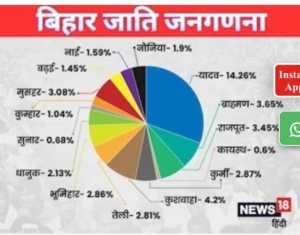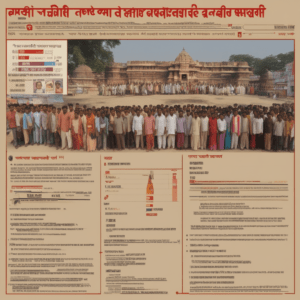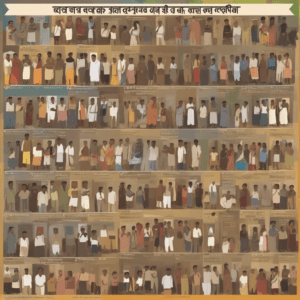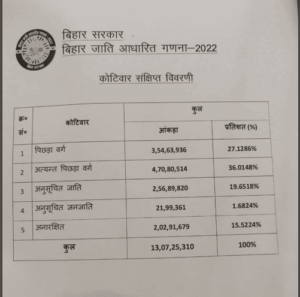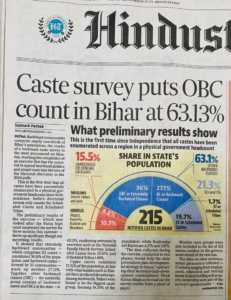Bihar Caste Census: A Comprehensive Analysis & its Political Implications (November 2023)
Bihar Caste Census Data Released: Possible Implications for School Education Sector
“Today on the auspicious occasion of Gandhi Jayanti, the data of the caste based census conducted in Bihar has been published. Many congratulations to the entire team engaged in the work of caste based enumeration. The proposal for the caste based survey was passed unanimously in the State legislature,” CM Nitish Kumar, October 2, 2023
Introduction
On October 2, 2023, the birthday of the Father of the Nation, Mahatma Gandhi, the Bihar Government released the data from its caste census, which was conducted in 2022. The census was the first of its kind in India in over 100 years, and it provides a comprehensive overview of the caste composition of the state’s population.
Caste Based Census in India 2023
Needfulness of Caste Census
There are several reasons why a caste census is essential. First, it can help to identify and address caste-based discrimination and inequality. Second, it can help to ensure that government policies and programs are designed based on caste census and implemented to benefit all castes and communities. Third, it can provide valuable data for research on caste and social mobility.
Period During Which Data Was Collected
The Bihar caste census was conducted in two phases: the first phase from January 7 to 21, 2022, and the second phase from April 15 to May 15, 2022. The census covered all households in the state, both rural and urban.
Data and Statistics
The caste census data shows that the Other Backward Classes (OBCs) are the largest caste group in Bihar, accounting for 52.8 percent of the population. The Scheduled Castes (SCs) and Scheduled Tribes (STs) account for 16.9 percent and 1.4 percent of the population, respectively. The Forward Castes account for 28.9 percent of the population.
Here is a list of the different castes in Bihar and their percentage of the population, based on the 2023 Caste Census:
| Caste Group | Percentage of Population |
| Extremely Backward Classes (EBCs) | 38.0 percent |
| Backward Classes (BCs) | 14.8 percent |
| Scheduled Castes (SCs) | 16.9 percent |
| Scheduled Tribes (STs) | 1.4 percent |
| Forward Castes | 28.9 percent |
The EBCs are the largest caste group in Bihar, accounting for 38.0 percent of the population. Some of the major EBC castes include: Yadav, Kurmi, Koeri, Koeri-Kurmi, Teli, Kushwaha, Mali, Bind, Nishad, Rajbhar and Paswan.
Perhaps the only other source of information on OBC population is UDISEPlus which presents enrolment distributed by SC, ST and OBC detailed analysis can be found at:
Exploring the Share of OBC Enrollment in India’s School Education System (2023)
The UDISE+ 2021-22 data reveals that OBC students constitute a significant share of the total enrollment in the school education system in India. Across all grades (Grades 1 to 12), the OBC enrollment share stands at 44.9 percent, indicating substantial progress in providing access to education for OBC students at various levels which is quite similar to Caste-based Census of Bihar.
Implications for the School Education Sector
The caste census data has will have several implications for the school education sector in Bihar. First, it can help the government to identify and address caste-based disparities in educational attainment and achievement. For example, the data shows that the SC and ST populations are underrepresented in higher education. The government can use this data to develop targeted programs to increase SC and ST students’ enrollment and graduation rates.
Second, the caste census data of Bihar can help the government to ensure that its school education policies and programs are designed and implemented to benefit all castes and communities. For example, the data shows that the OBC population is the largest caste group in Bihar. The government can use this data to ensure that OBC students have access to quality education and meet their needs.
Finally, the caste census data can be used to research caste and social mobility in the school education sector. For example, researchers can use the data to study the factors contributing to students’ educational success from different caste groups. This research can inform the development of evidence-based policies and programs to bridge educational equity for all students in Bihar.
Here are some specific examples of how the Bihar caste census data can be used to improve the school education sector:
- The government can use the data to identify schools with a high concentration of students from disadvantaged caste groups. These schools may need additional resources and support to ensure that all students have the opportunity to succeed.
- The government can use the data to develop targeted programs to improve student’s learning outcomes from disadvantaged caste groups. These programs could focus on providing additional academic support, addressing social-emotional barriers to learning, or creating inclusive school environments.
- The government can use the data to track students’ progress from disadvantaged caste groups over time. This data can be used to identify areas where additional interventions are needed.
The Bihar caste census data is one of the essential resources that can be used to improve the school education sector for all students, not only in the state of Bihar but for the entire country.
Bihar Caste-based Census Download Full List of Castes and Percentages (PDF)

